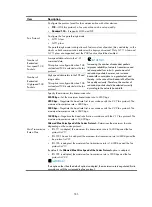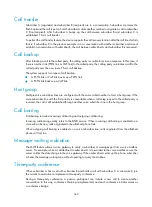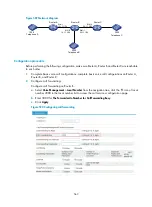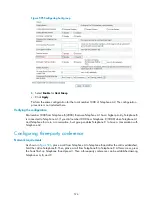
560
Call transfer
Subscriber A (originator) and subscriber B (recipient) are in a conversation. Subscriber A presses the
flash hook and the call is put on hold. Subscriber A dials another number to originate a call to subscriber
C (final recipient). After Subscriber A hangs up, the call between subscriber B and subscriber C is
established. This is call transfer.
To perfect the call transfer feature, the device supports the call recovery function after the call transfer fails,
that is, if subscriber C in the previous example is in a conversation with another subscriber and cannot
establish a conversation with subscriber B, the call between subscriber A and subscriber B is recovered.
Call backup
After initiating a call to the called party, the calling party is unable to receive a response. In this case, if
there is another link (PSTN link or VoIP link) to the called party, the calling party re-initiates a call to the
called party over the new route. This is call backup.
The system supports two types of call backup:
•
A PSTN link or VoIP link backs up a PSTN link.
•
A PSTN link backs up a VoIP link.
Hunt group
Multiple voice subscriber lines are configured with the same called number to form a hunt group. If the
voice subscriber line with the first priority is unavailable when a call setup request to the called party is
received, the call is still established through another voice subscriber line in the hunt group.
Call barring
Call barring includes incoming call barring and outgoing call barring.
Incoming call barring usually refers to the DND service. When incoming call barring is enabled on a
voice subscribe line, calls originated to the attached phone fails.
When outgoing call barring is enabled on a voice subscriber line, calls originated from the attached
phone will fail, too.
Message waiting indication
The MWI feature allows a voice gateway to notify a subscriber of messages got from a voice mailbox
server. For example, when a call destined to subscriber A is forwarded to the voice mailbox server, the
server notifies the state change to the voice gateway. When subscriber A picks up the phone, subscriber
A hears the message waiting tone without needing to query the mailbox.
Three-party conference
When subscriber A has a call with subscriber B and holds a call with subscriber C, A can make C join
the current conversation to implement a three-party conference.
During a three-party conference, a passive participant can initiate a new call to create another
conversation. In this way, conference chaining is implemented, and each conference initiator serves as
a conference bridge.
Summary of Contents for MSR SERIES
Page 17: ...xv Documents 835 Websites 835 Conventions 836 Index 838 ...
Page 20: ...3 Figure 3 Initial page of the Web interface ...
Page 42: ...25 Figure 13 Firefox Web browser setting ...
Page 59: ...42 Figure 27 Checking the basic service configuration ...
Page 73: ...56 Figure 35 Sample interface statistics ...
Page 156: ...139 Figure 139 Rebooting the 3G modem ...
Page 168: ...151 Figure 152 Configuring Web server 2 ...
Page 174: ...157 Figure 158 Configure the URL filtering function ...
Page 242: ...225 Figure 233 Enabling the DHCP client on interface Ethernet 0 1 ...
Page 247: ...230 Figure 236 The page for configuring an advanced IPv4 ACL ...
Page 255: ...238 Figure 241 Advanced limit setting ...
Page 298: ...281 e Click Apply 2 Configure Router B in the same way Router A is configured ...
Page 400: ...383 Figure 387 Verifying the configuration ...
Page 405: ...388 ...
Page 523: ...506 Figure 530 Ping configuration page ...
Page 775: ...758 Figure 785 Configuring a jump node ...






























